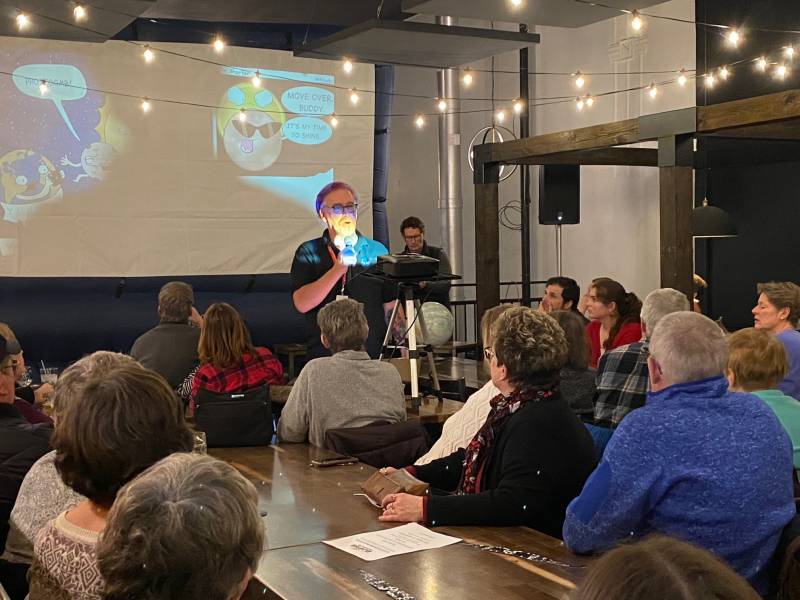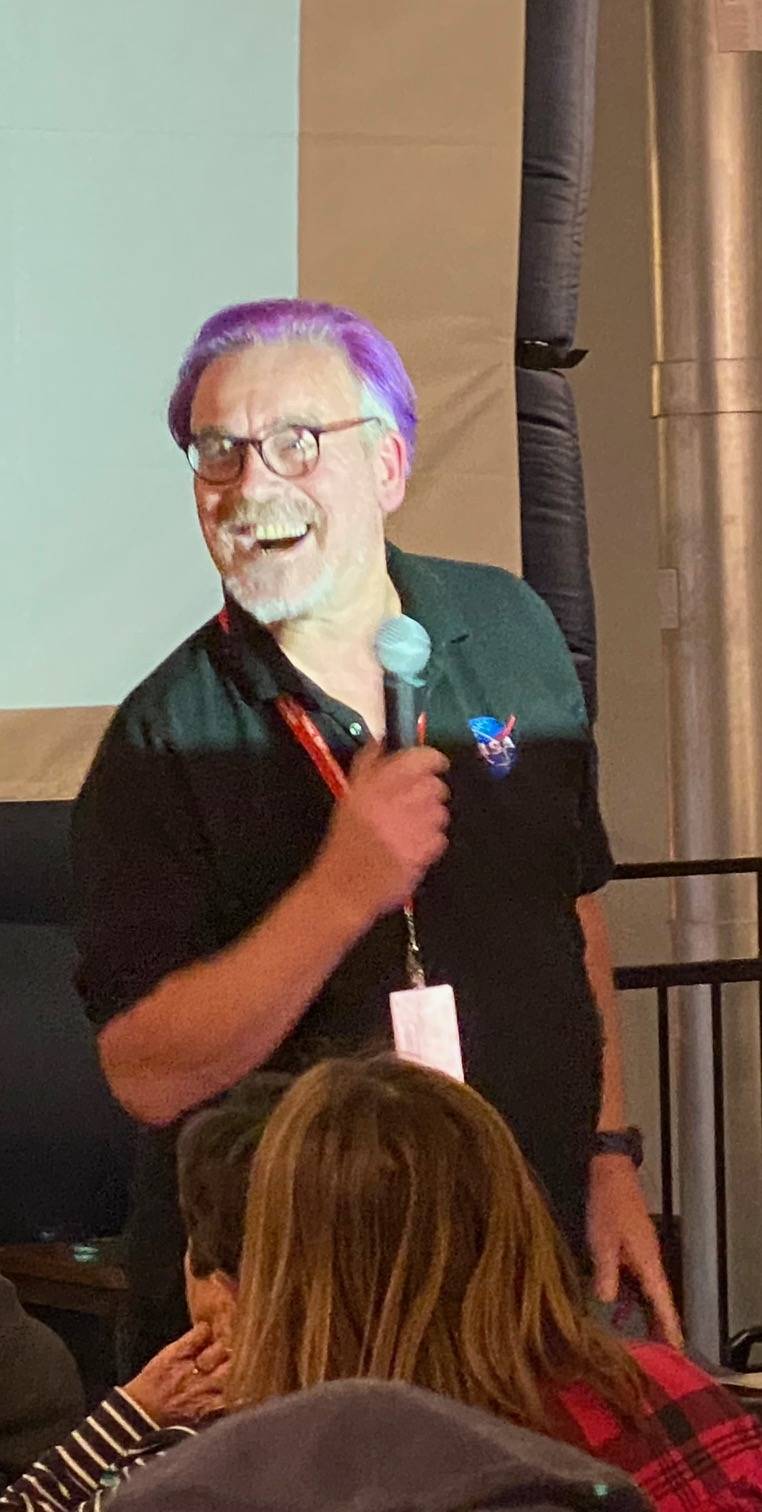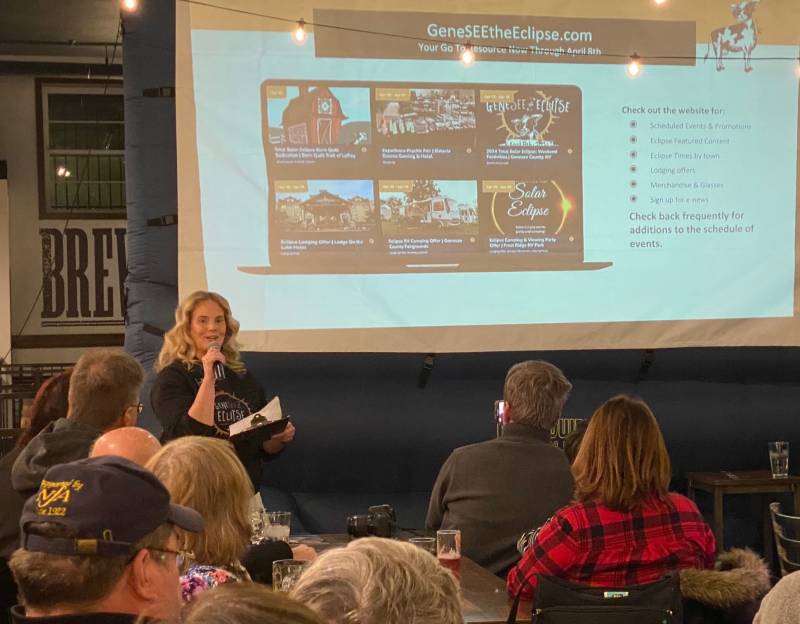
Photo by Joanne Beck
How do you organize a total solar eclipse party? You planet.
It wasn’t long before the collective “ahhhh” came from an audience Tuesday that had registered for retired science teacher and NYS Science Teacher’s Association fellow Gene Gordon’s total solar eclipse presentation.
While there may be some people still uncertain as to why this is a big deal for Genesee County, those 100 folks can now appreciate that, come April 8, when a total solar eclipse occurs, “Buffalo, Batavia, and Rochester are right smack in the middle of it,” Gordon said.
“So you can actually be looking and watching it getting closer and closer, which is a really cool thing,” he said during the event at Eli Fish Brewing Company in Batavia.
Not to confuse that comment with his warning a few minutes later. For those intending to view the eclipse, do not look at the sun, he said. He equated that to staring at the UV light emitted from welding equipment, which will burn your corneas, he said. That’s what those funky black-and-white cow-themed 3-D viewing sunglasses are for, he said, referring to the free pair everyone received with registration.
As for warnings, that also goes for taking photos or using binoculars or a telescope without solar filters, he said.
Gordon’s work included creating a NASA research class, and science.nasa.gov has images and details about the eclipse and a description of what will actually happen on April 8: A total solar eclipse happens when the moon passes between the sun and Earth, completely blocking the face of the sun. People viewing the eclipse from locations where the moon’s shadow completely covers the sun – known as the path of totality – will experience a total solar eclipse. The sky will darken as if it were dawn or dusk. Weather permitting, people along the path of totality will see the sun’s corona, or outer atmosphere, which is usually obscured by the bright face of the sun.
Once the eclipse arrives, it will be evident by a blanket of darkness. Even if it gets cloudy, viewers ought to be able to see totality, he said.
Animals, highly sensitive to shifts in nature, may give clues for the impending arrival by acting differently, possibly wanting to hide or respond as if it’s actually nighttime (so nocturnal creatures might be waking up) even though it will be approximately 3:19 p.m. on that Monday afternoon.
Think everyone else will be hard at work? Maybe not. School districts are closing for the day so that students can participate in eclipse activities, and the Chamber of Commerce and other area organizations and businesses are planning events to celebrate what will be a once-in-a-lifetime happening for many citizens, especially right here in Genesee County.
The next total solar eclipse will be on Aug. 23, 2044, to be visible from Greenland, northern Canada and in Montana and North Dakota.
Scott and Becky Kelley of Batavia plan to take the day off from work so that they can participate in this piece of local history with their three-year-old grandson.
“He’s very interested in planets,” Scott said. “He knows all the planets, he loves anything to do with space.”
The couple plans to do something with family in a field in Le Roy that day. Their grandchild served as motivation to attend the presentation, and they learned a few things about the upcoming event.
“I didn’t know what to expect, it was very interesting,” Becky said. “I didn’t know the exact times.”
The eclipse path should begin to arrive around 2:06 p.m., and in Genesee County at 3:19 p.m., with a maximum time of 3:21 p.m., Gordon said. The total eclipse is to end by 3:23 p.m. “You’ve got around four minutes,” he said.
One of the “coolest things” to do before, during and after the event is to definitely take photos, Gordon said, but focus on the people and activities around you.
“It’s a party,” he said. “And stay a couple of hours afterward; the roads will be jammed. Try to have fun and experience it in a meaningful way.”
Janice Spiotta joined her mom, Mary Hodgins, for the outing, and they are planning for a family gathering --- with one member coming from Boston — on April 8 as well. It seemed like a good idea to attend the presentation for future planning, Janice said.
“Because it's a once-in-a-lifetime event, and I want to learn what I need to know to make the most of the viewing and see what's going on in our community,” the Batavia resident said, answering where she would view the eclipse. “I’m not 100 percent sure yet. We live in the town where there's not streetlights and it's darker, so we may just do it in our backyard. But I've also heard that maybe the Genesee County Park, or at DeWitt Park, might be good locations. So we haven't decided yet.”
They each found some of Gordon’s talking points surprising.
“The size of it (compared to other planets), I was amazed at that,” Hodgins said. “I have a lot of people coming here from out of town, one of my daughters is coming in.”
Spiotta thought the impact on animals was interesting, she said, “and we’ll hear the birds and the activity of even crickets and things before we even can see it ourselves.”
“I thought that was fascinating,” she said.
Chamber marketing director Katy Hobbs reminded attendees that they can purchase the book, “Genny Sees the Eclipse,” a children’s book that describes how the animals respond to the eclipse and ensuing darkness, and other related merchandise, plus see the list of upcoming events at GeneSEEtheEclipse.com.

Photo by Joanne Beck

Photo by Joanne Beck

Photo by Joanne Beck

Photo by Joanne Beck
